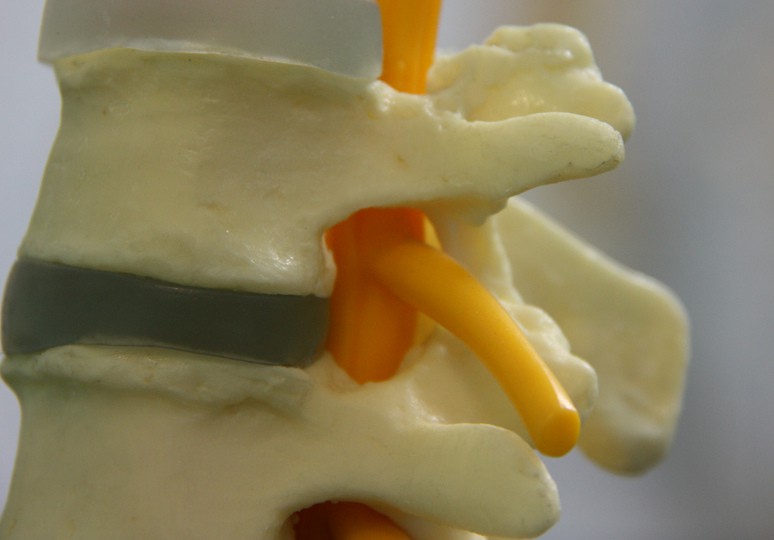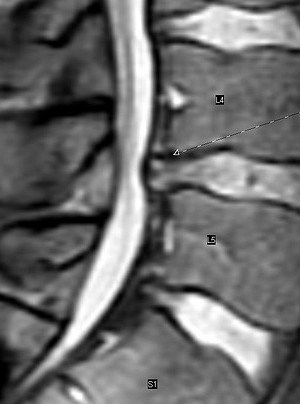Ever wonder what the difference is between a herniated disc, a slipped disc, a bulging disc, and a ruptured disc? Those terms are often thrown around haphazardly, and sometimes it’s hard to know exactly which condition we’re talking about. How do you know you have one of these conditions, and most importantly, what’s the best treatment to get out of pain?
In this post we hope to answer common questions about disc problems and point you in the right direction to find pain relief.
What is an intervertebral disc and what does it do?
 Let’s start out with the basics. Between each of your vertebrae is a cushion with fluid in the center. This cushion, the intervertebral disc, not only keeps the vertebrae separate, but absorbs shock and supports the weight of the body. The disc also maintains space for nerves to extend from the spinal column to the rest of the body. The larger your disc, the more room there is for the nerve.
Let’s start out with the basics. Between each of your vertebrae is a cushion with fluid in the center. This cushion, the intervertebral disc, not only keeps the vertebrae separate, but absorbs shock and supports the weight of the body. The disc also maintains space for nerves to extend from the spinal column to the rest of the body. The larger your disc, the more room there is for the nerve.
What is a herniated disc?
Over time, discs become smaller and a bit deflated as we age. This can cause problems in itself. But discs are also subject to injury—often through improper lifting of heavy objects—or can be compressed by a misalignment in the vertebrae.
If the vertebrae puts uneven pressure on the disc, the fluid may cause a bulge (or hernia) in the disc.
If the disc puts pressure on the nerve, it can result in severe pain in the back. Depending on the location of the herniated disc, pain can also radiate into the hip, pelvis, or groin. In some cases, pain or numbness may reach down to the calf and even the toes.
What’s the difference between a herniated disc, slipped disc and a bulging disc?
Unfortunately, these terms can cause confusion, especially for patients who visit multiple doctors and are told by one they have a herniated disc, by the next that they have a bulging disc, and so forth.
In reality, these three terms are synonyms and all refer to the same condition.
How is a herniated disc treated?
 In the past, back surgery was often recommended for herniated disc pain, but unfortunately the success rate for this procedure has been significantly low. The growing trend in the medical community is to avoid this kind of surgery except in extreme cases or when the disc is actually ruptured (see next section).
In the past, back surgery was often recommended for herniated disc pain, but unfortunately the success rate for this procedure has been significantly low. The growing trend in the medical community is to avoid this kind of surgery except in extreme cases or when the disc is actually ruptured (see next section).
The good news is that for most people, the non-surgical route is quite effective for solving the problem and ending pain. Re-aligning the vertebrae through a chiropractic adjustment in many cases alleviates the pressure on the disc and is enough to stop the bulge, relieve pressure on the nerve, and stop the pain.
What is a ruptured disc, and how is it treated?
Sometimes when a disc is under extreme pressure or is acutely injured, the tissue can tear and the fluid begin to leak out.
While a herniated disc can often be treated without surgery, with a ruptured disc surgery is needed in nearly 100% of cases. Because the disc itself may deflate and no longer be able to support the vertebrae, the surgeon may need to implant artificial means of supporting the vertebrae.
Watch the video below to see a visual model of a herniated disc and what surgery on a ruptured disc looks like.
What should I do if I suspect I have a disc problem?
If you are experiencing back pain and suspect it may be disc problem, you have two choices: you can visit a traditional medical doctor first, or you can visit a chiropractor first.
Typically, a medical doctor runs diagnostic tests (such as an MRI) to rule out the possibility of a ruptured disc, and then will prescribe an anti-inflammatory to bring any swelling down. He or she may recommend the use of a steroid, and then may recommend surgery, or else regular physical therapy and/or chiropractic care.
Unfortunately, this approach can be time-consuming. Because of increasing pressures on doctors’ offices, at least a week may elapse between when you first call and your first appointment. Waiting to schedule an MRI may take another 2 weeks. If you need to talk to a surgeon, you may wait even longer.
All of this means you may be waiting several weeks before finding any relief from your pain! And if the cause of your pain is a misaligned vertebra putting pressure on a disc, prescription medications won’t actually get to the root of the problem. And at the end of all of the waiting, it may be you are referred to a chiropractor anyway.
If you visit a chiropractor first, however, you may be able to skip many of the extra steps and tackle the source of the problem at the outset. A good chiropractor will start out doing diagnostic tests to rule out the possibility of a ruptured disc (in which case he or she will refer you to a surgeon). But if no surgery is required, treatment can begin right away to relieve pressure on the nerve.
We’ve found that in 70% of cases, those suffering with a herniated disc are out of pain within 2 weeks.
If you’re suffering from pain from a herniated disc—or any kind of back or neck pain—contact our office right away. We want to get you out of pain and back on your feet as soon as possible!
Other articles about herniated disc, slipped disc, and ruptured disc treatment
https://proadjusterchiropractorvirginiabeach.com/exercises-for-herniated-discs/
Photo credits: Disc models by ![]() Michael Dorausch via Compfight; Herniated disc MRI by
Michael Dorausch via Compfight; Herniated disc MRI by ![]() Scott via Compfight
Scott via Compfight

Leave A Comment